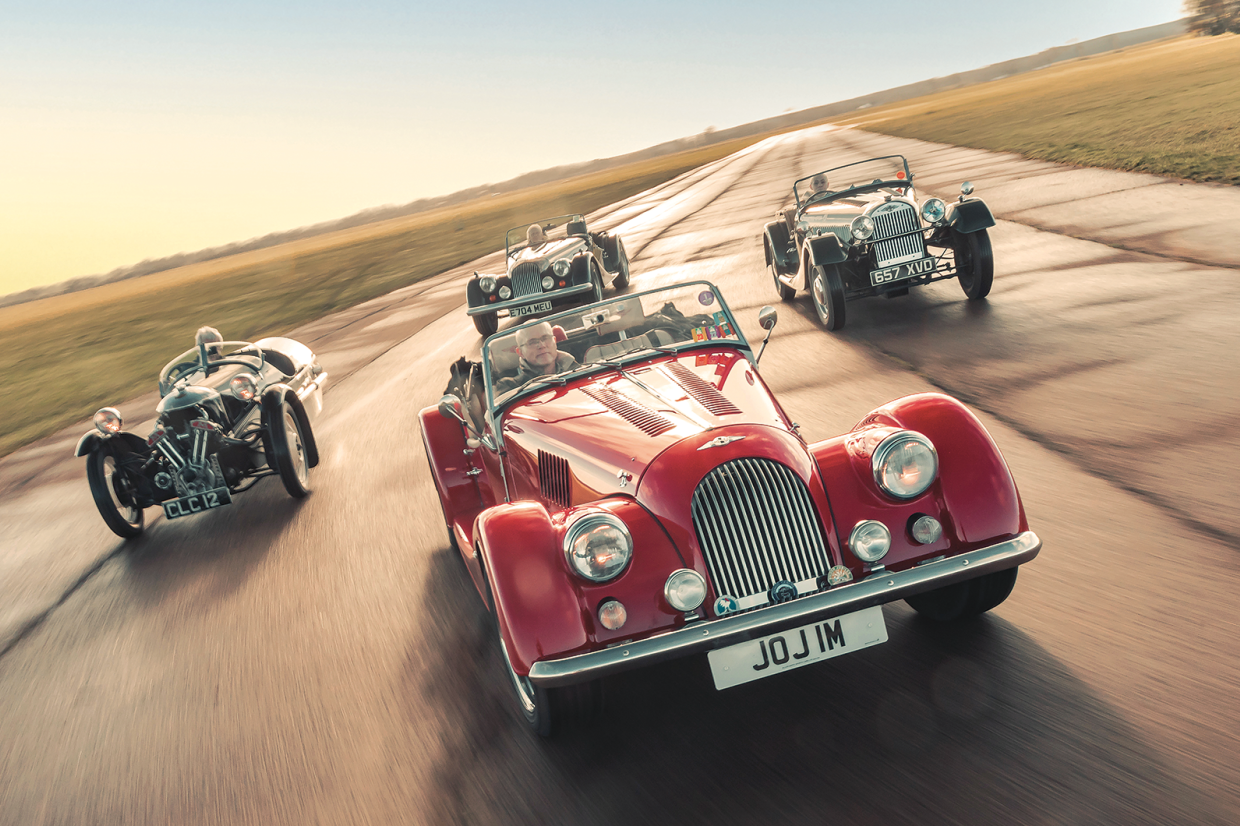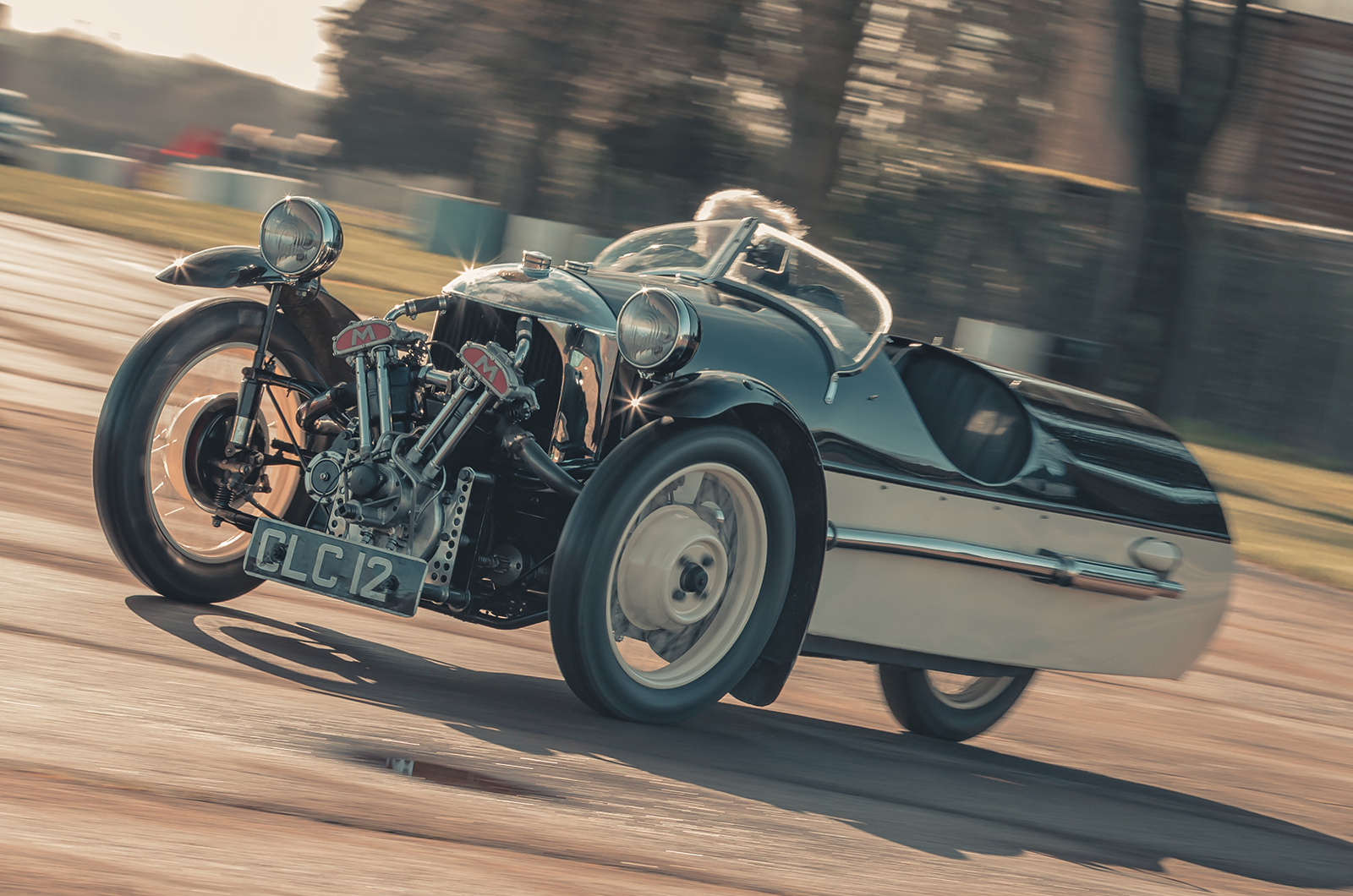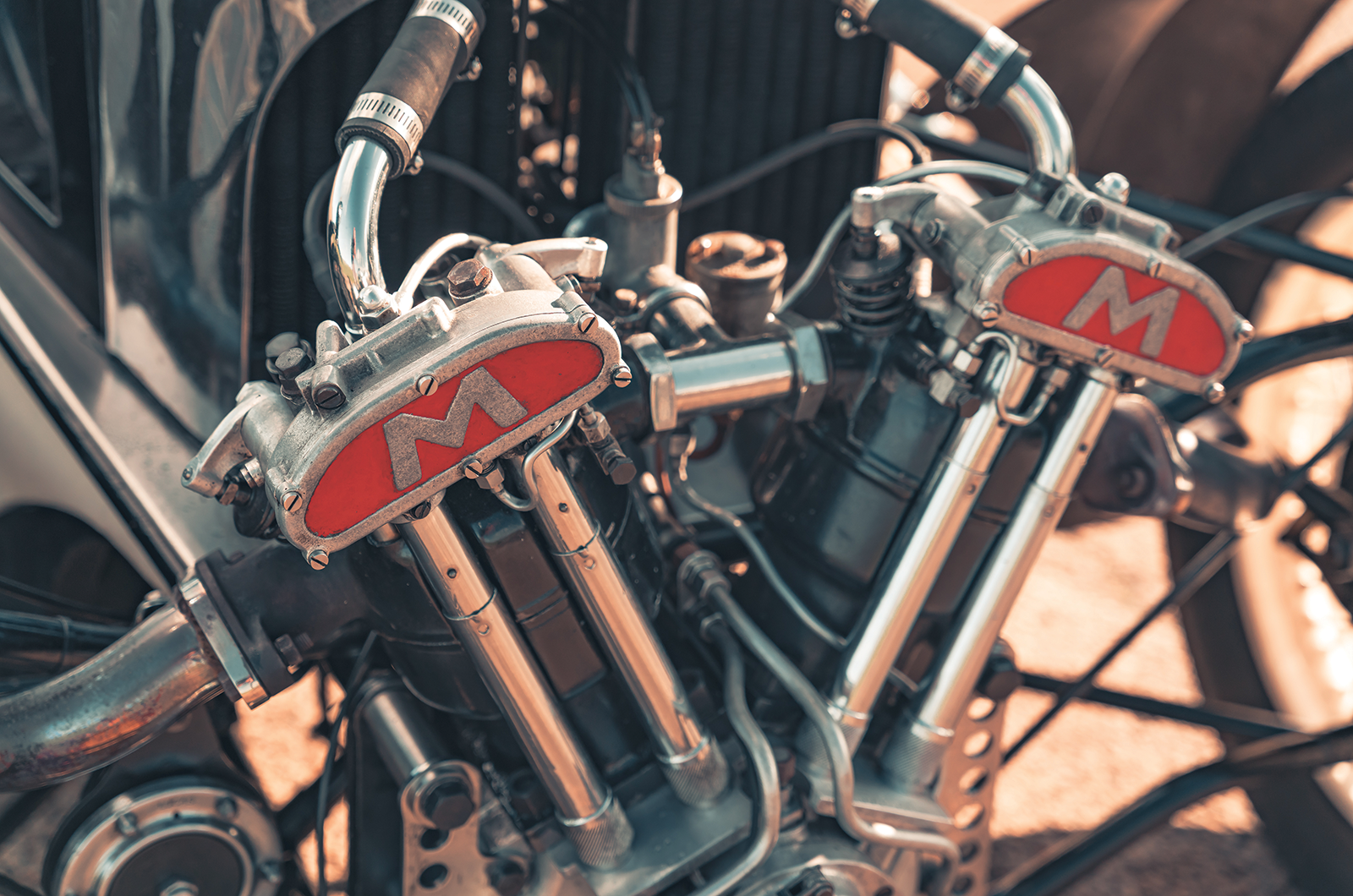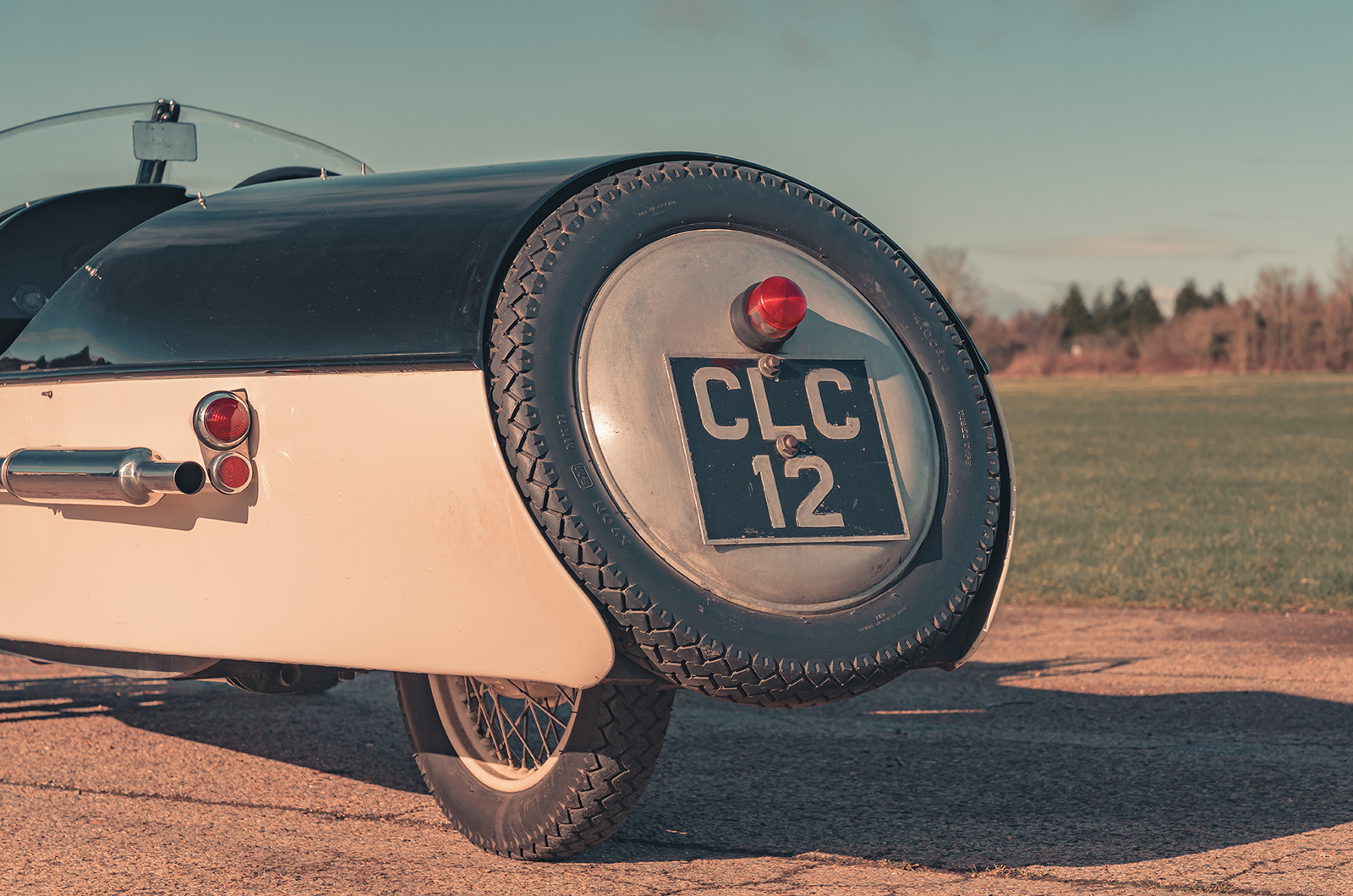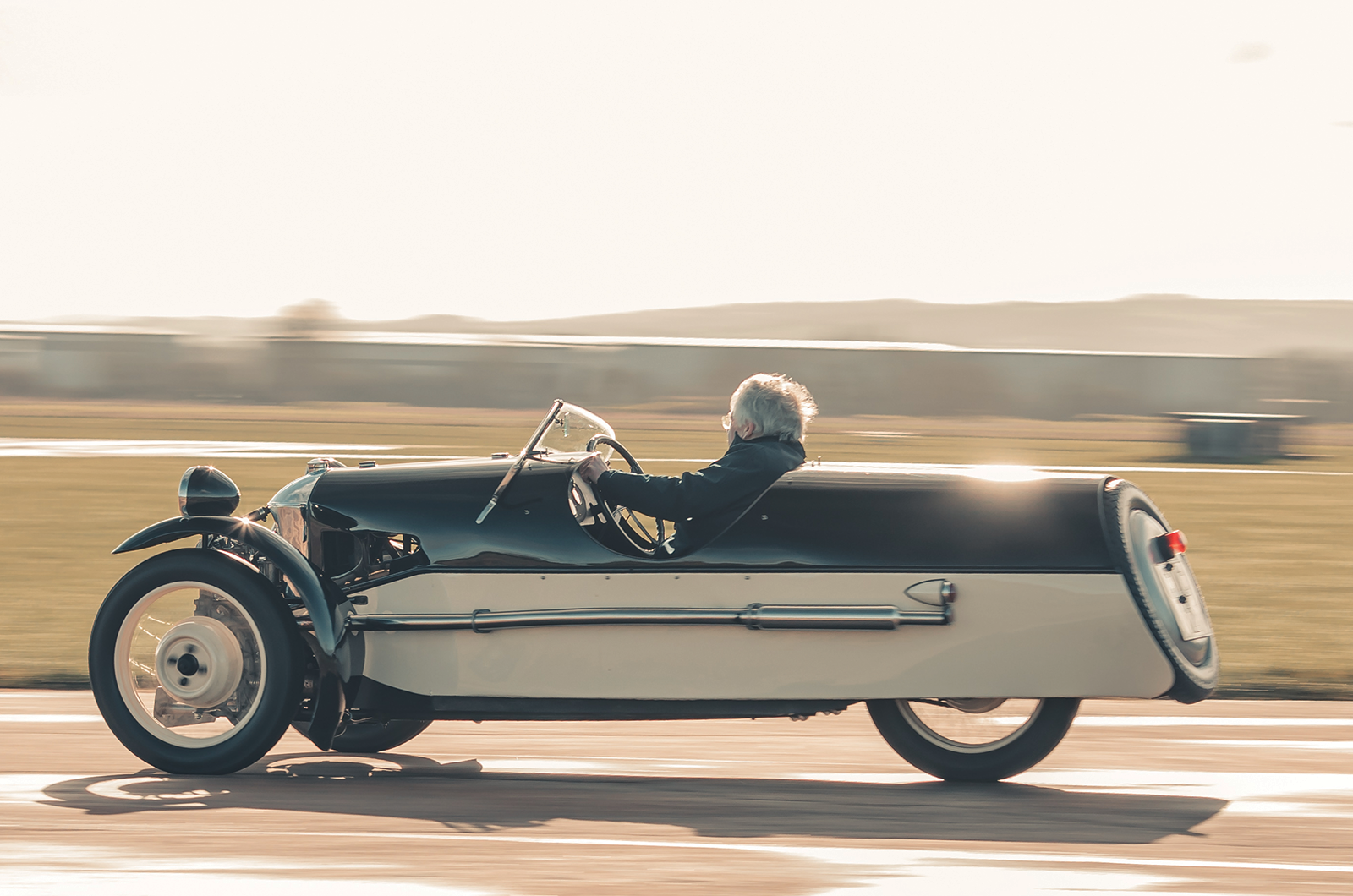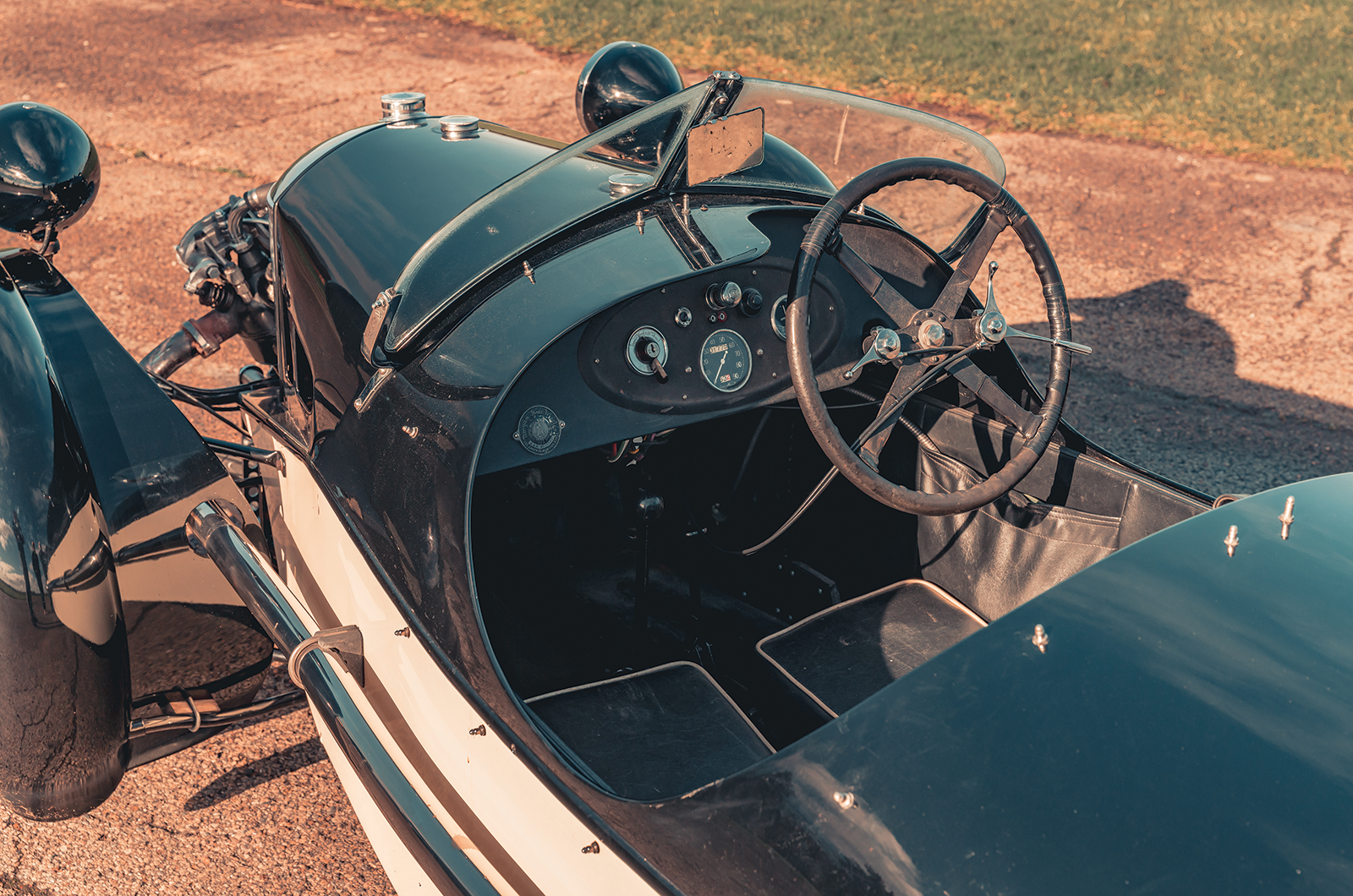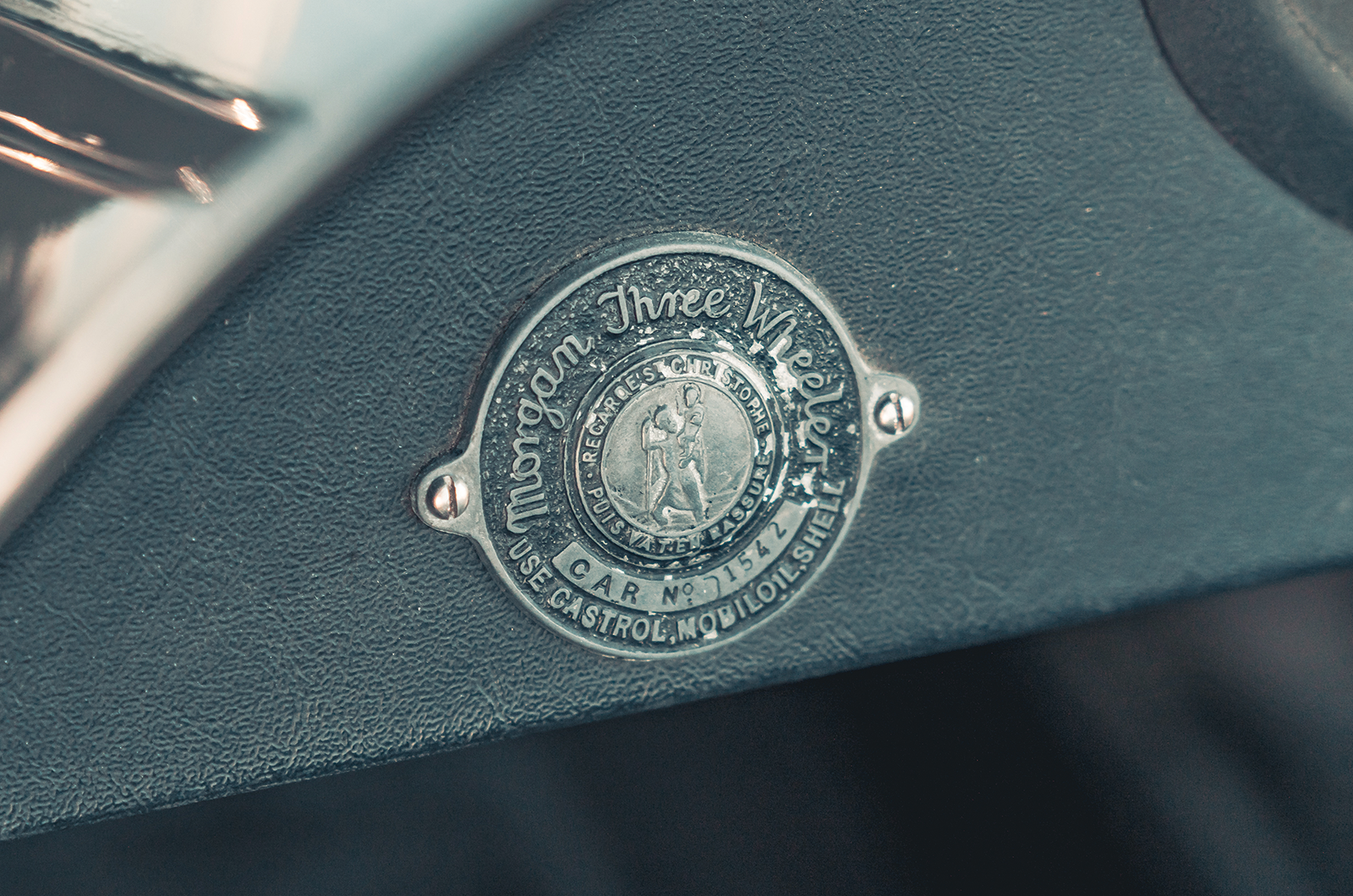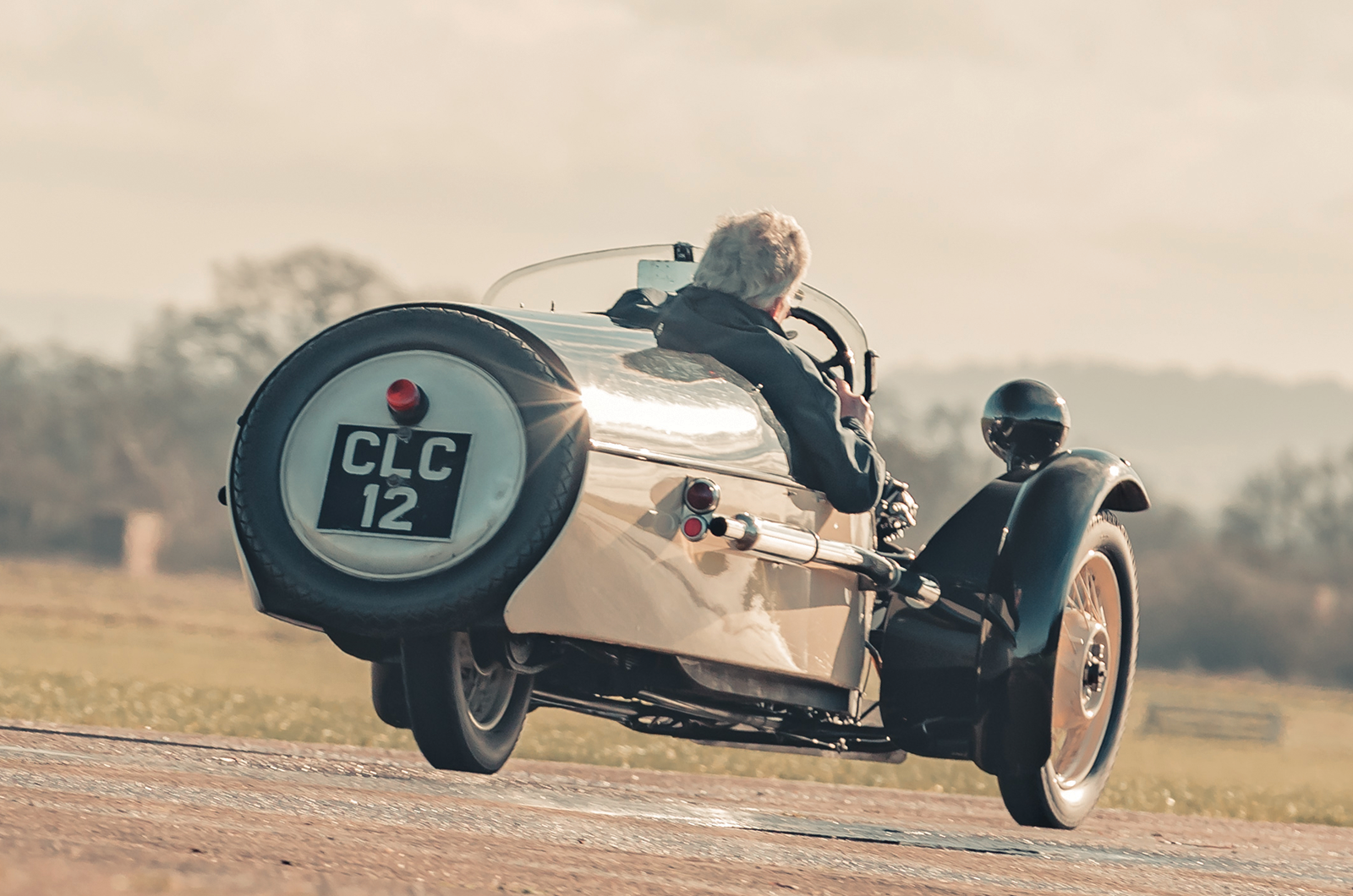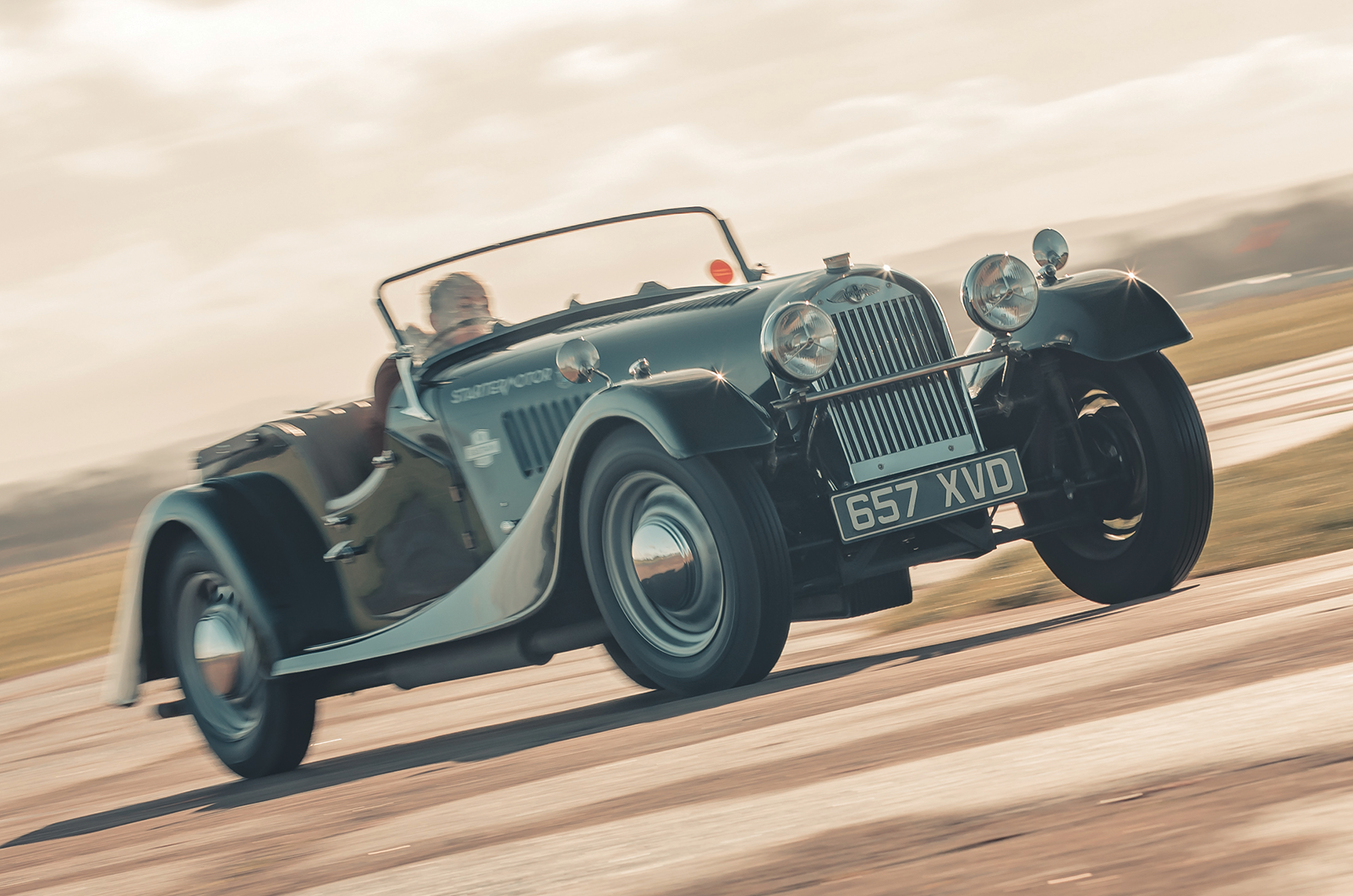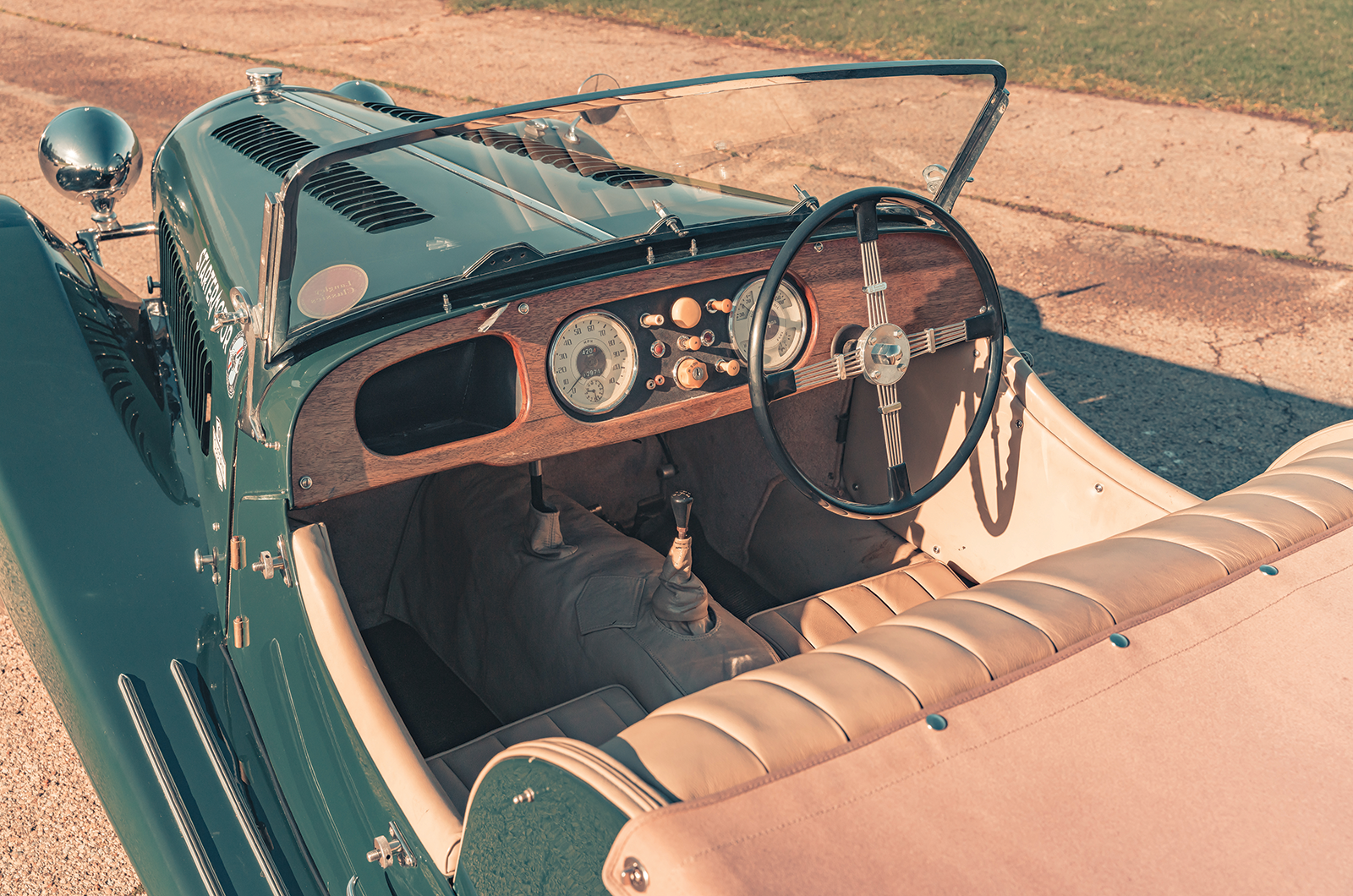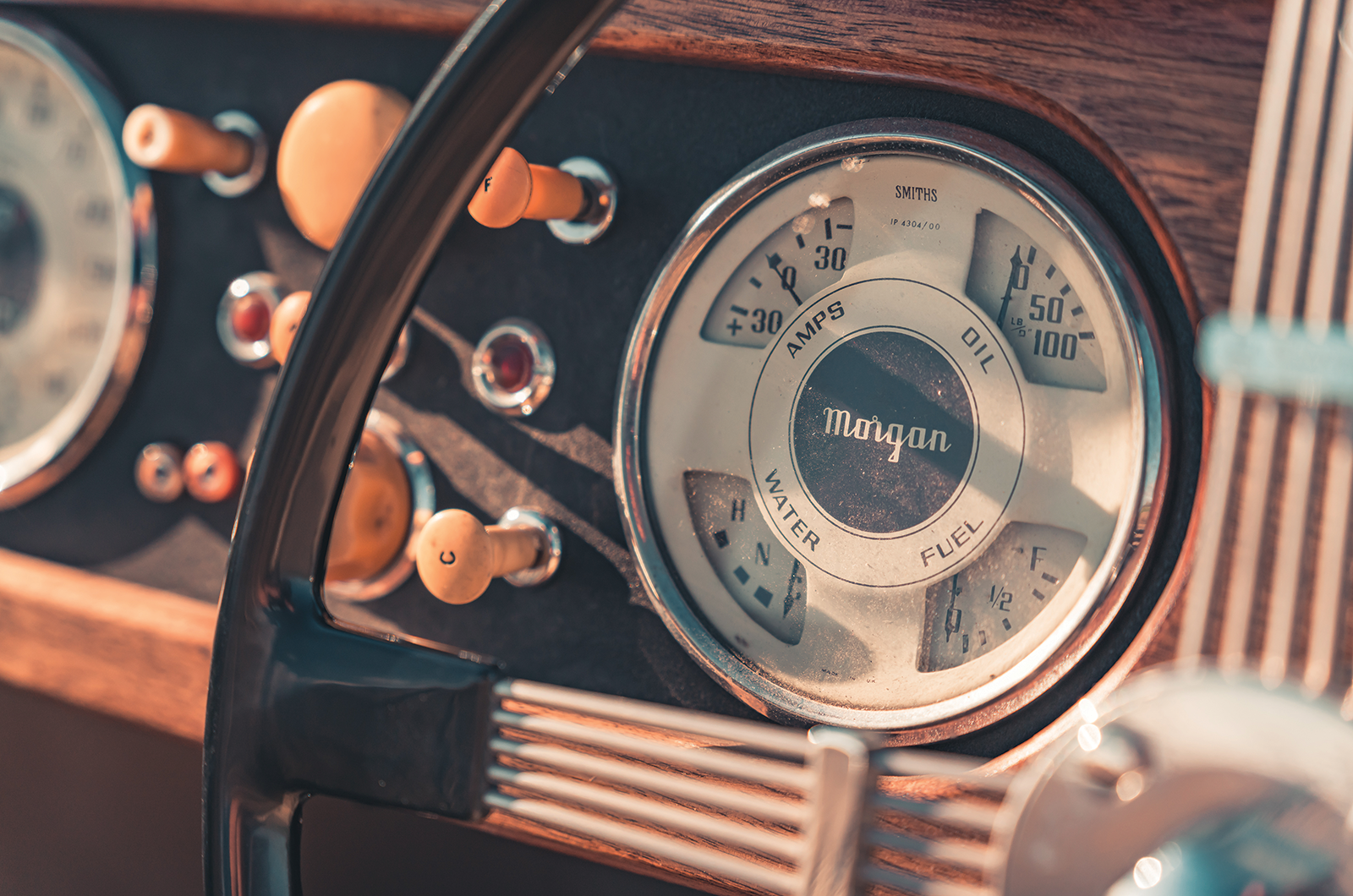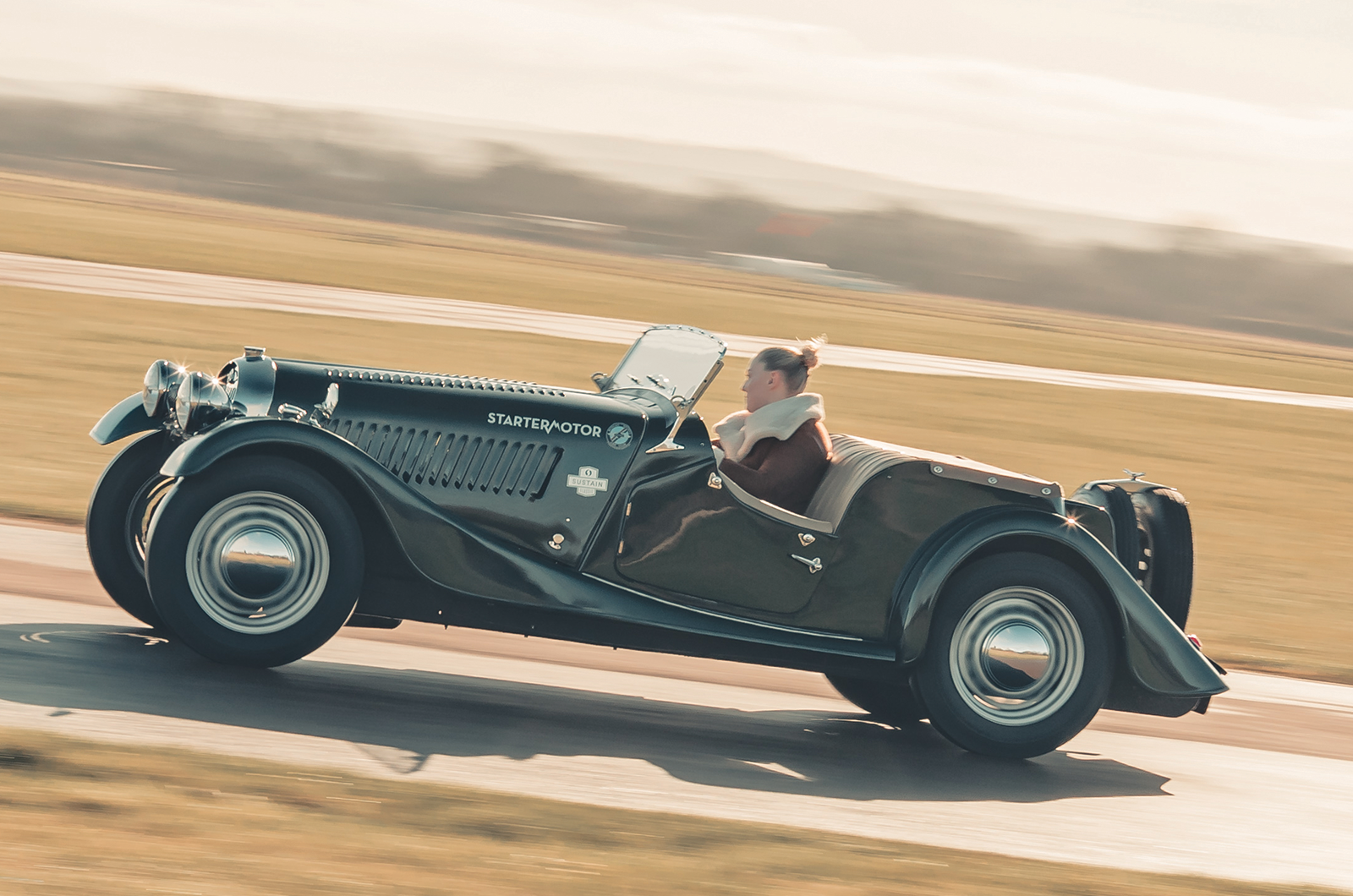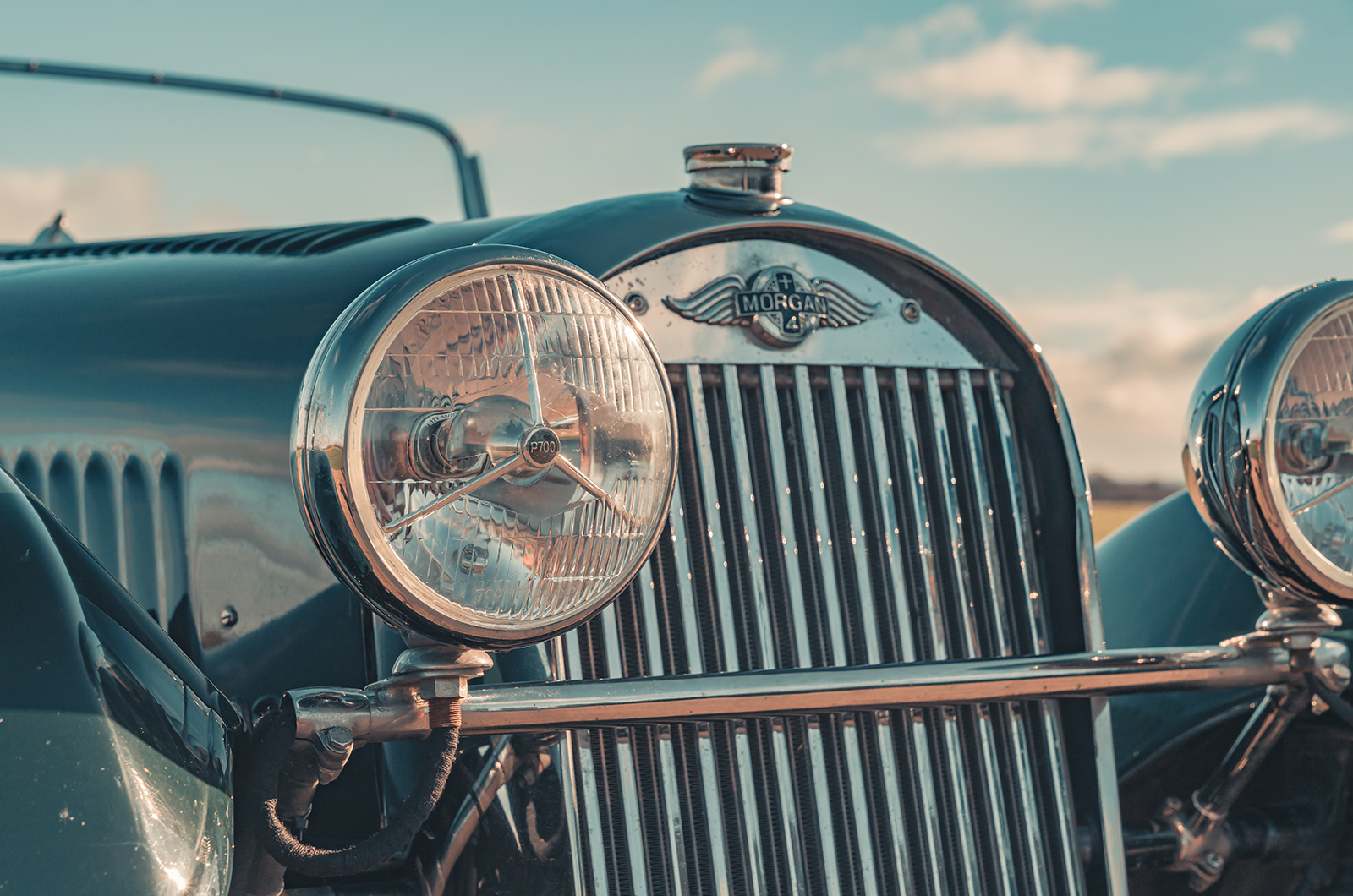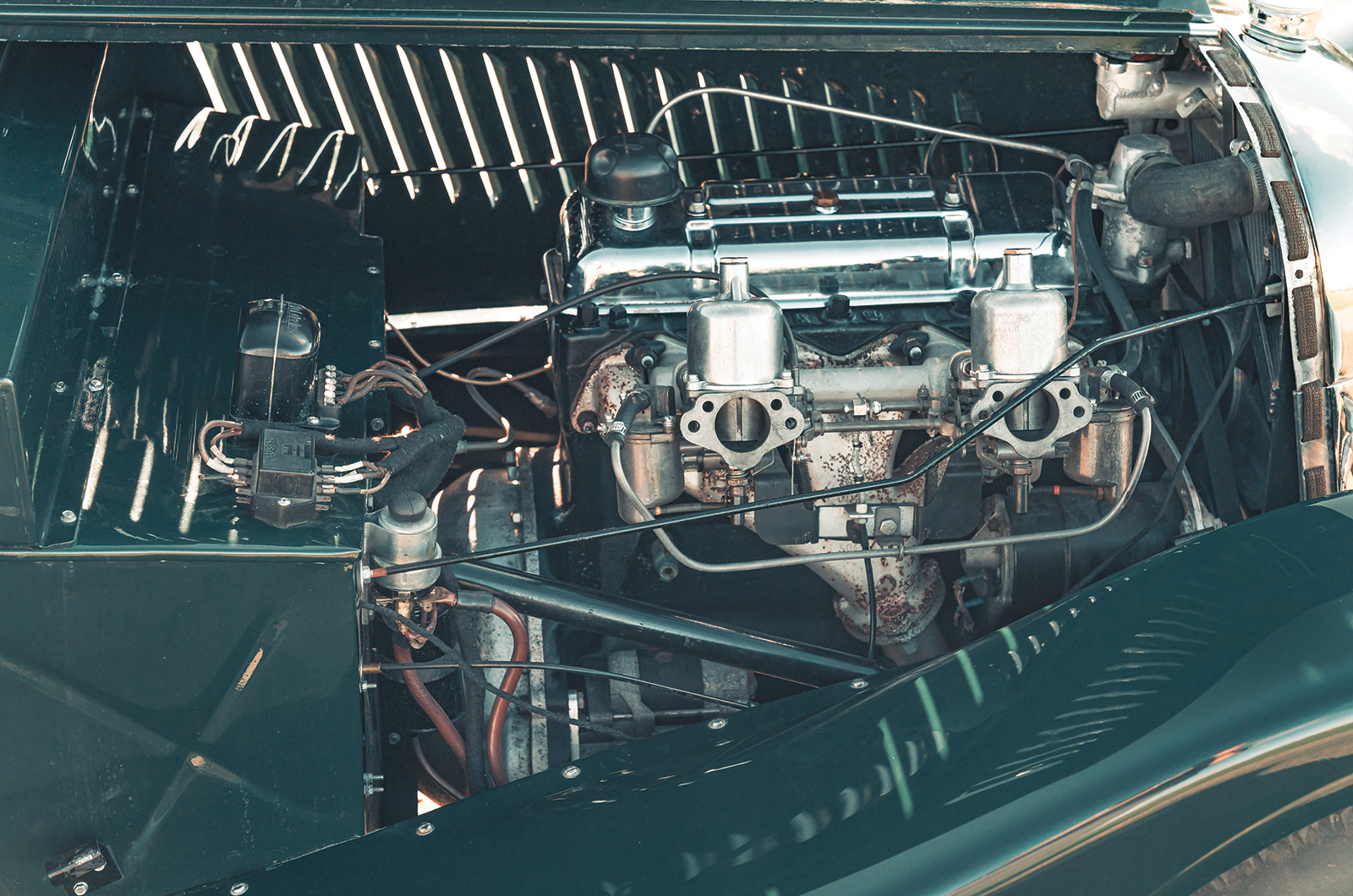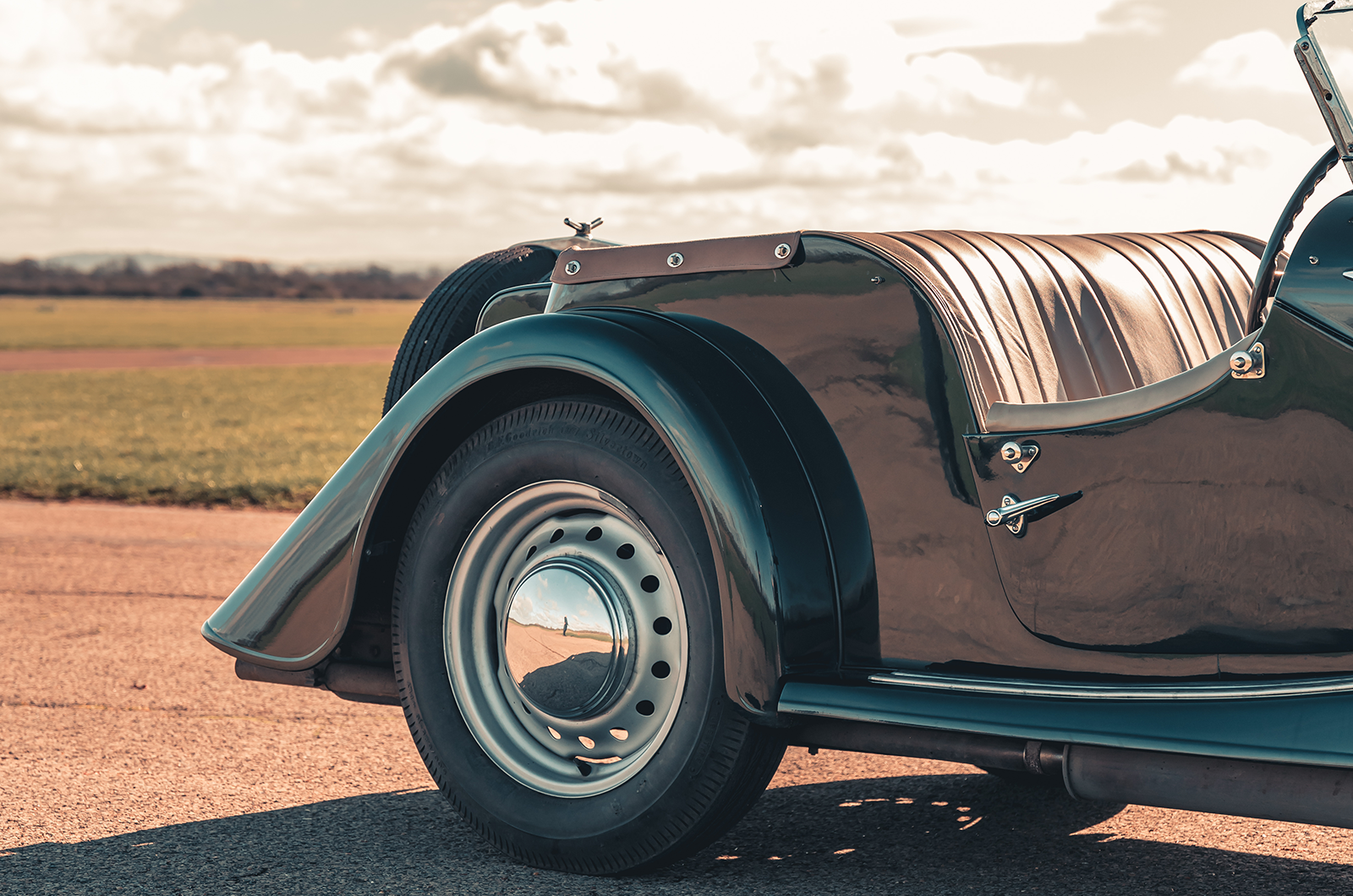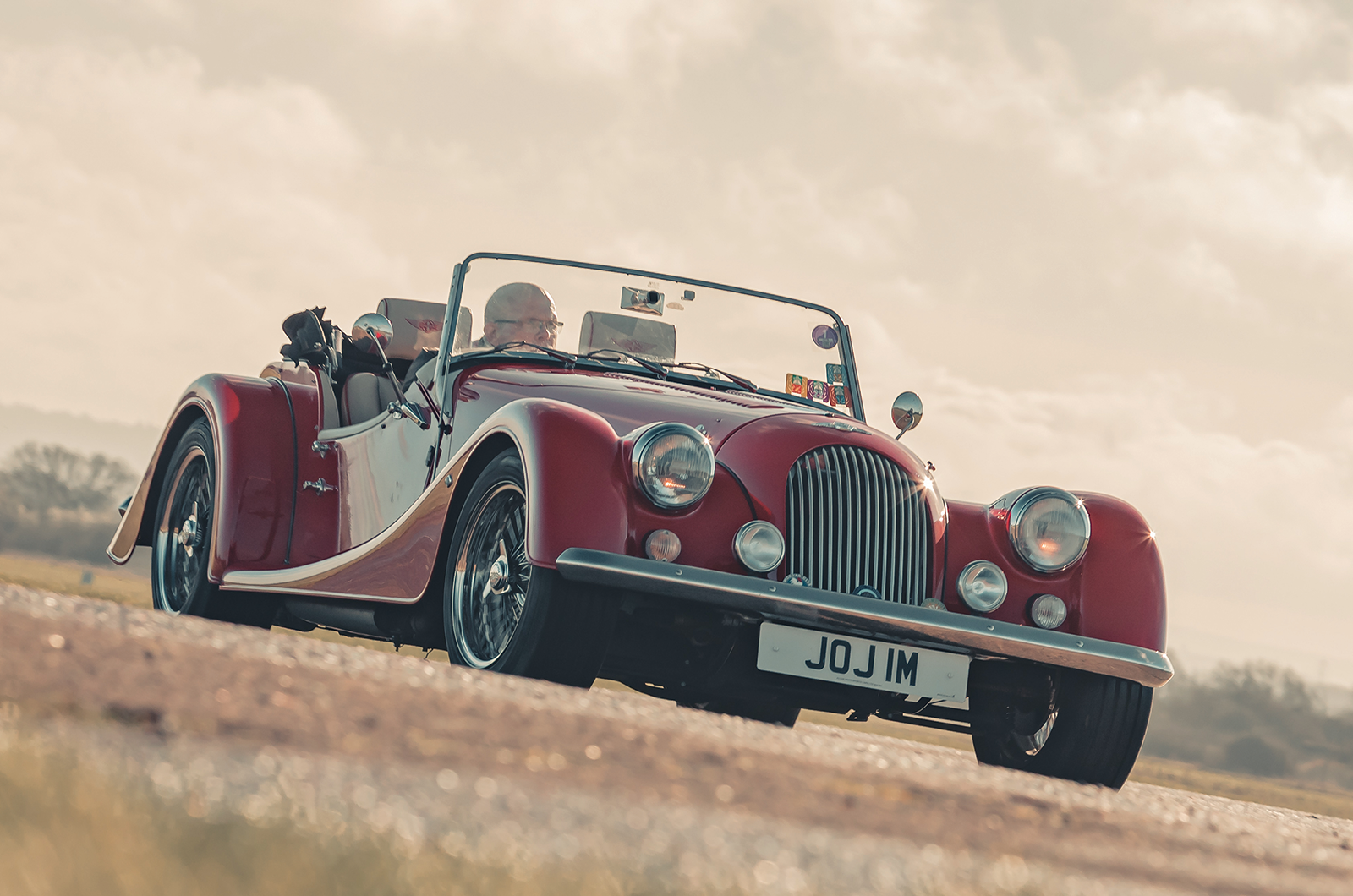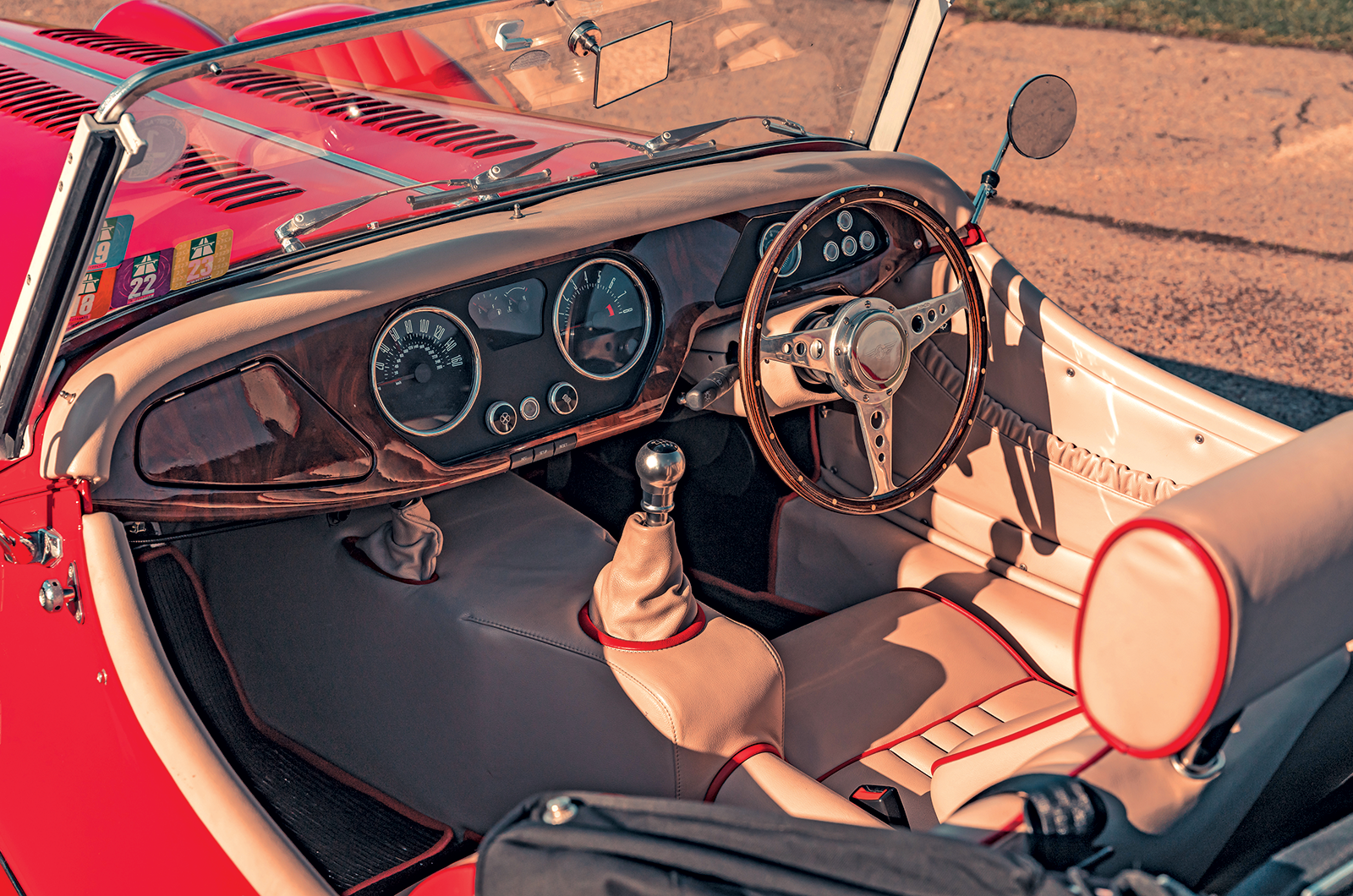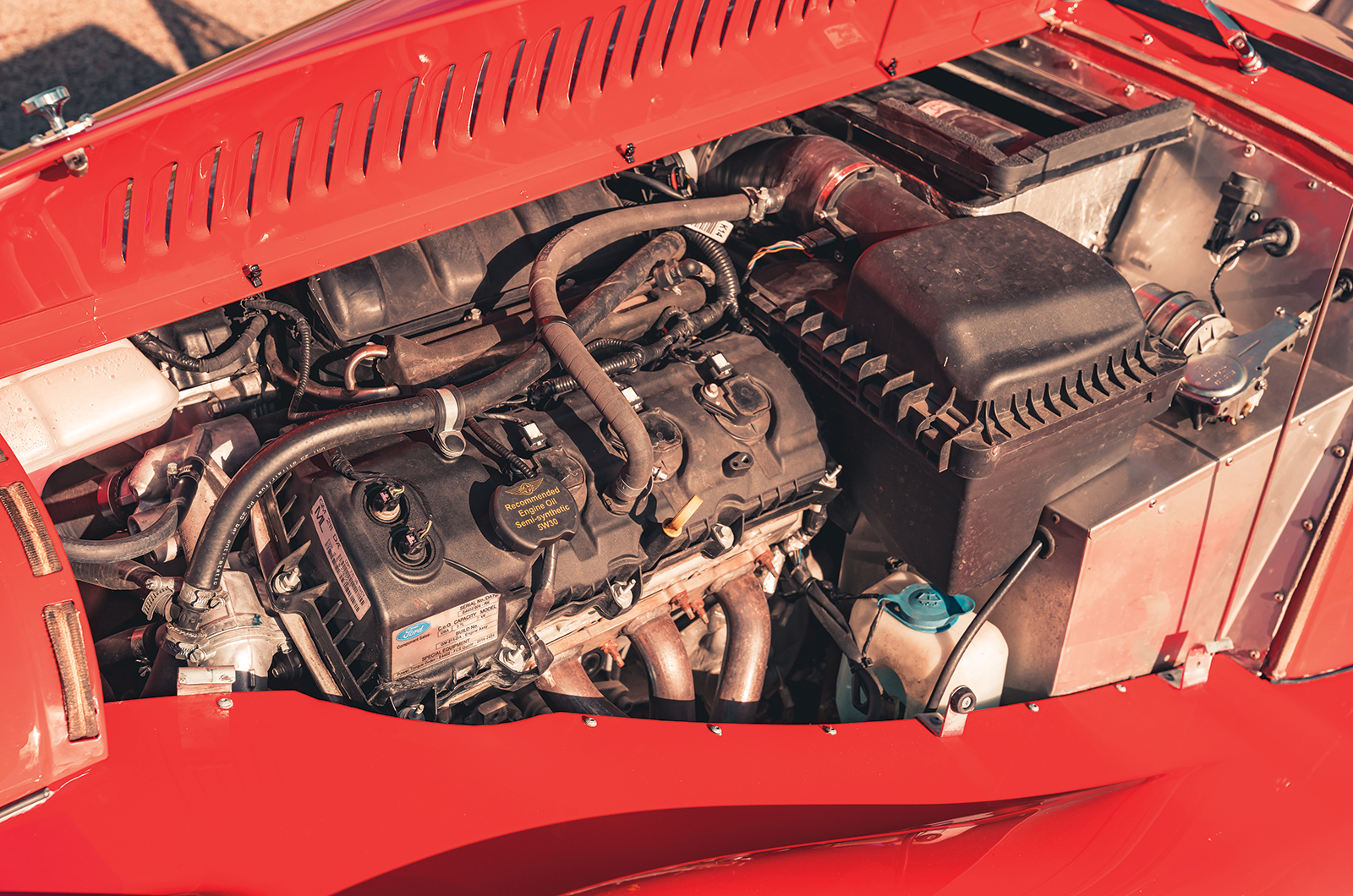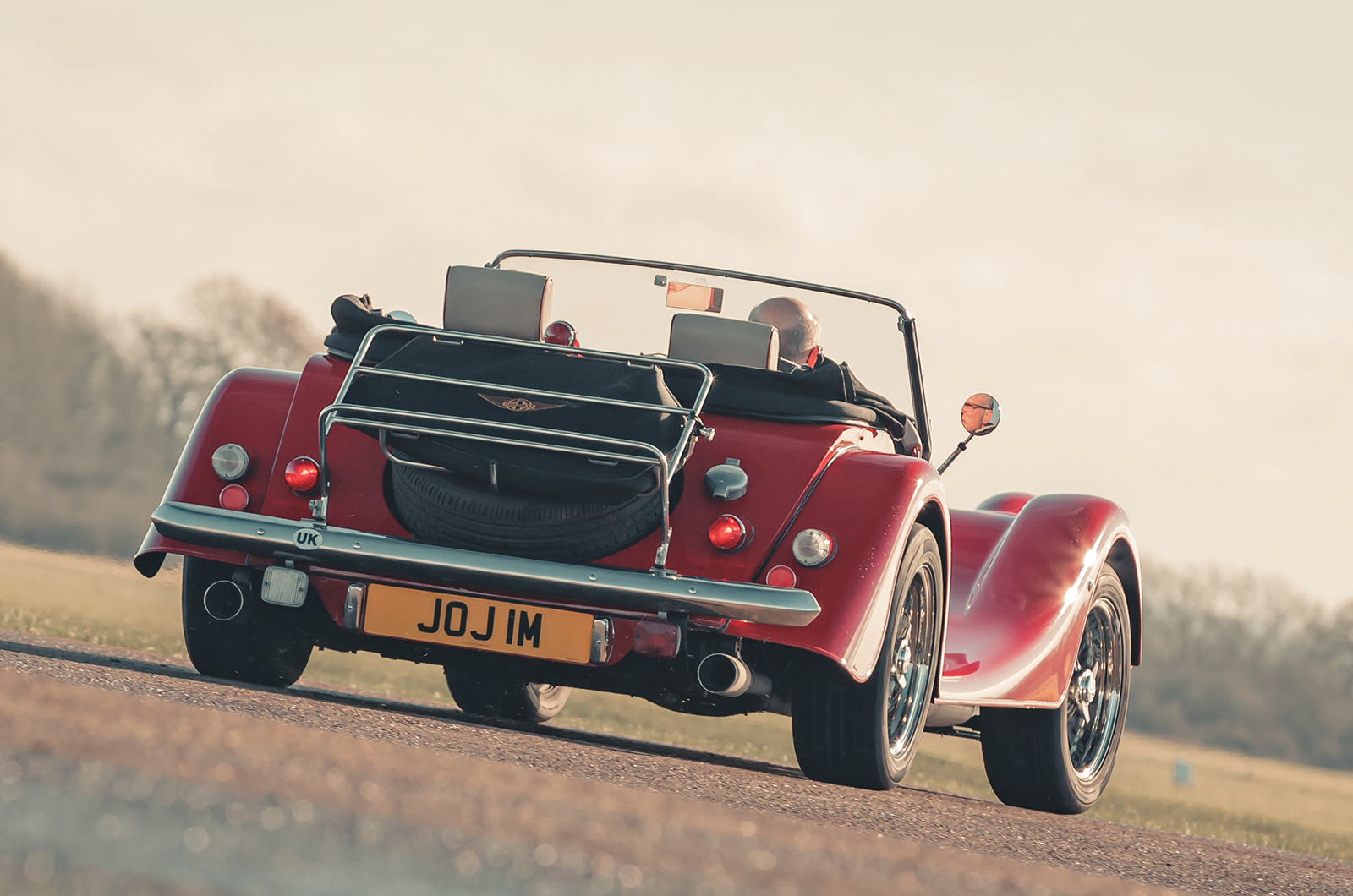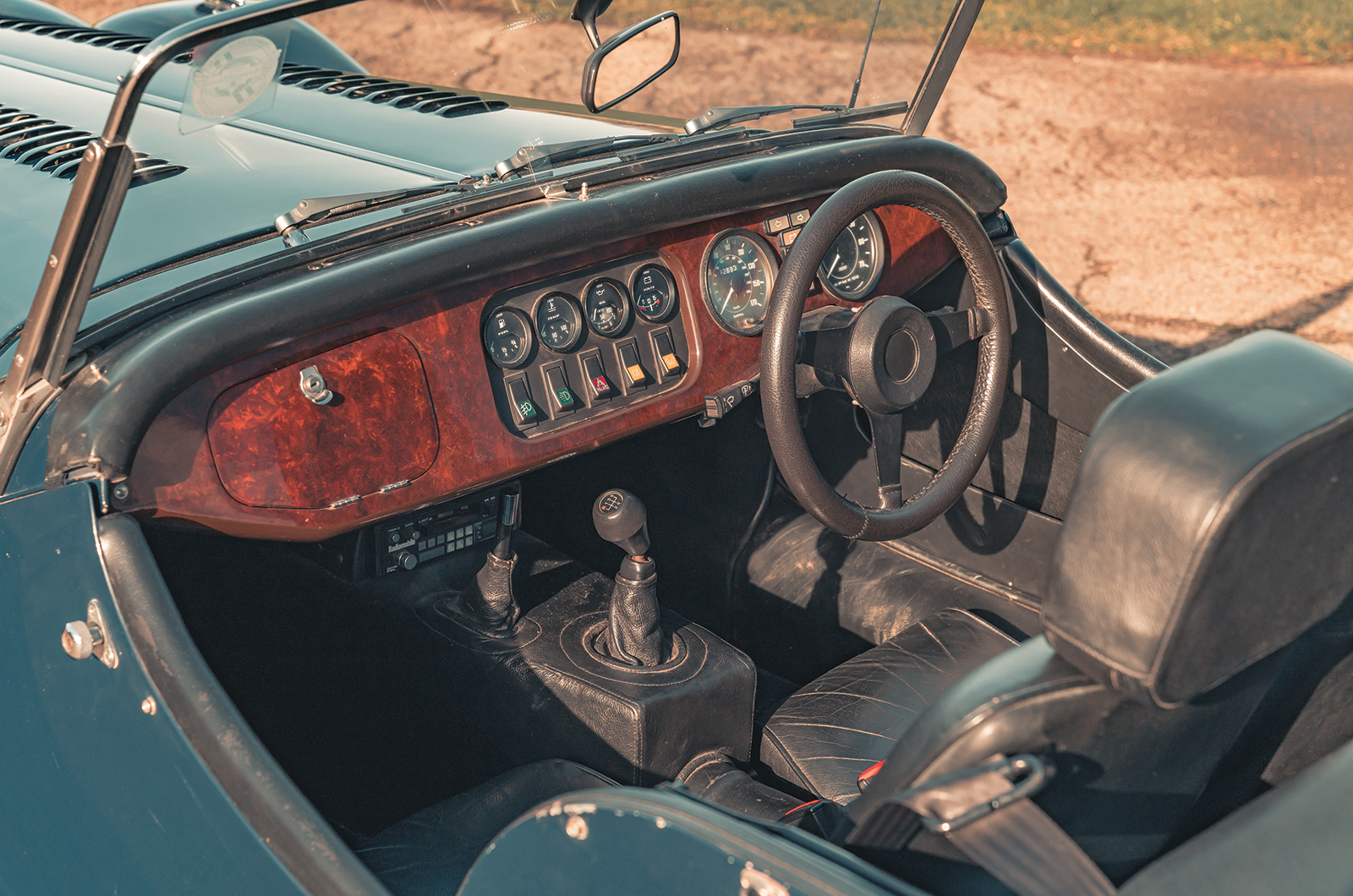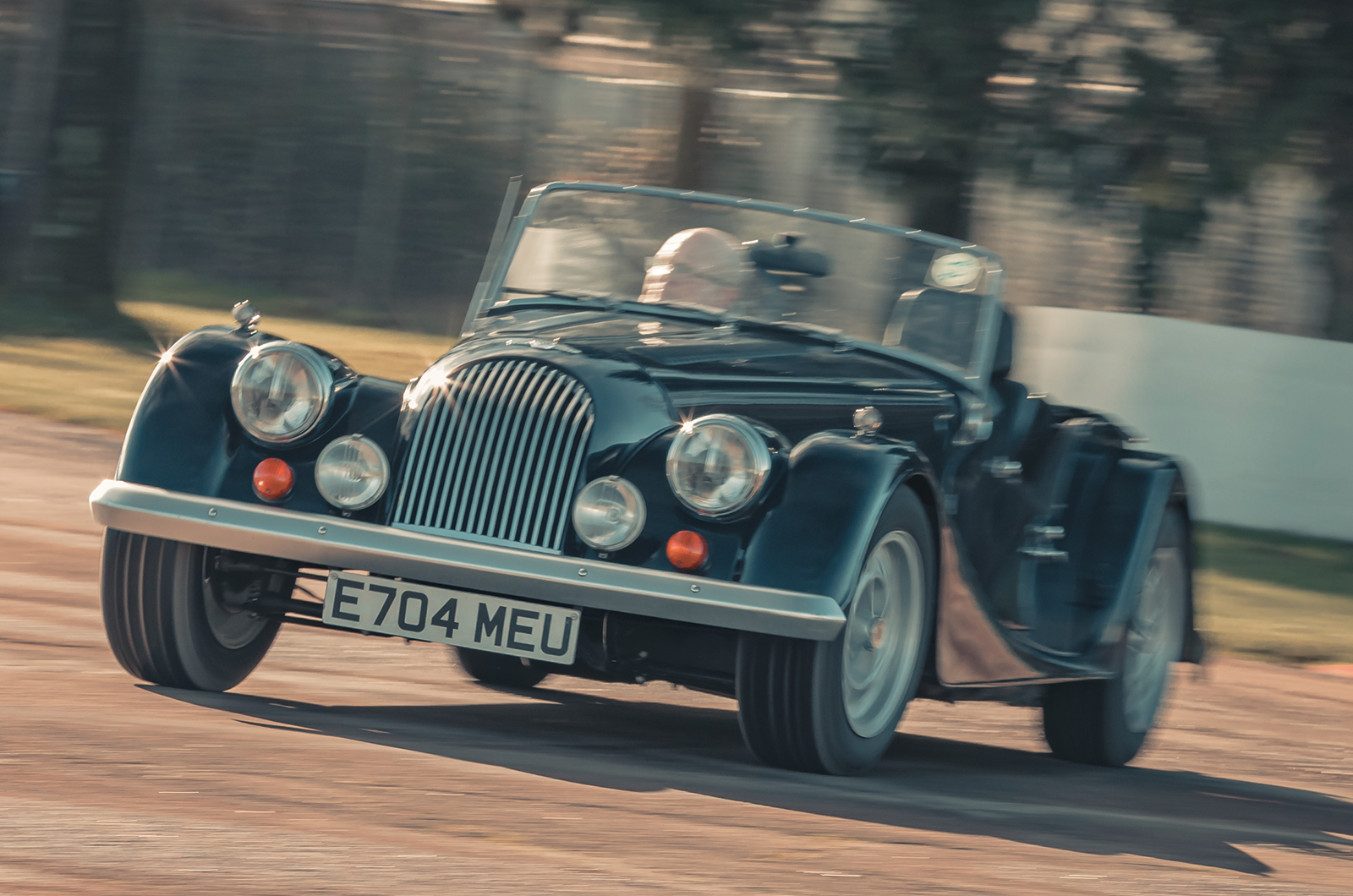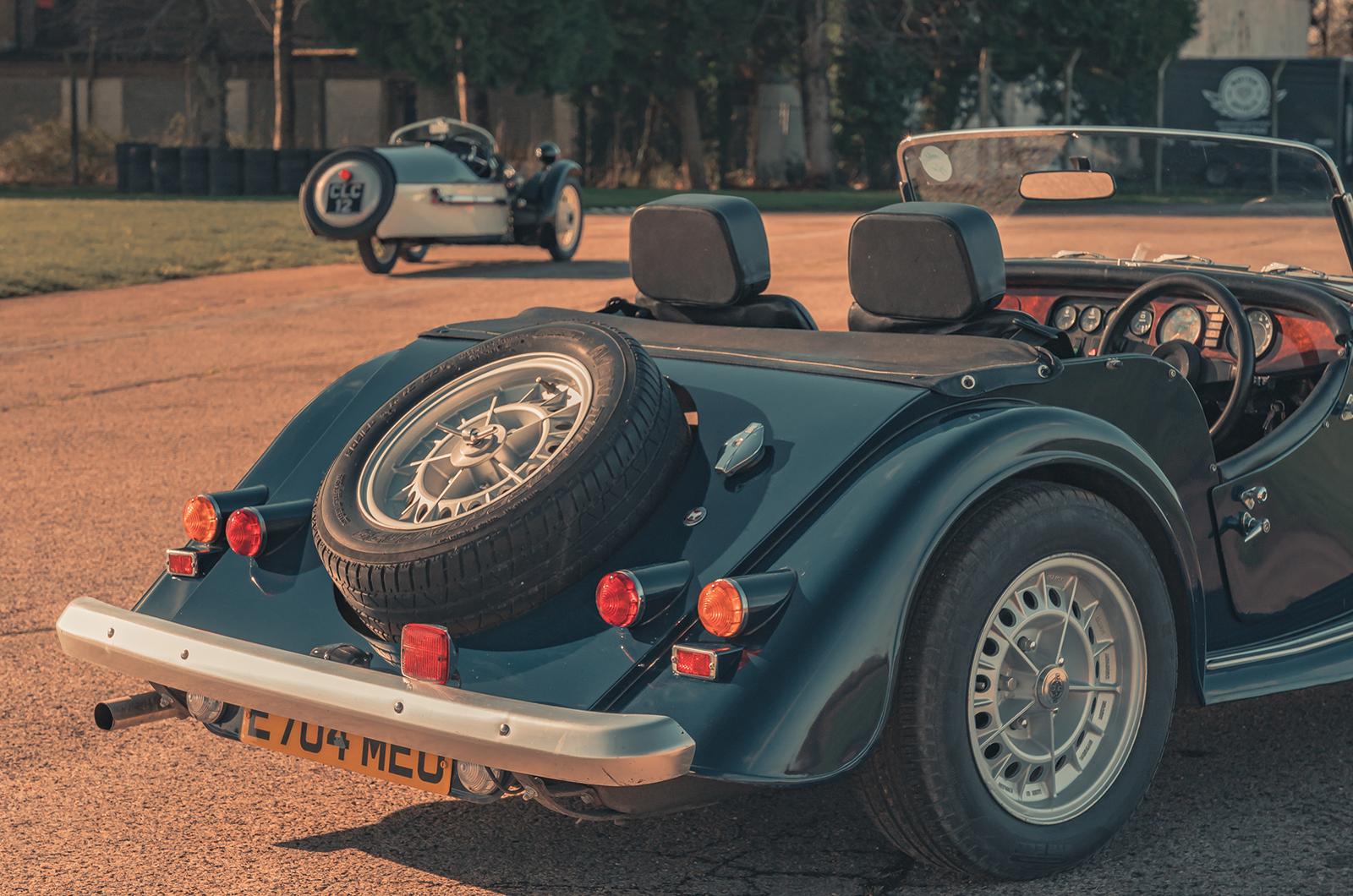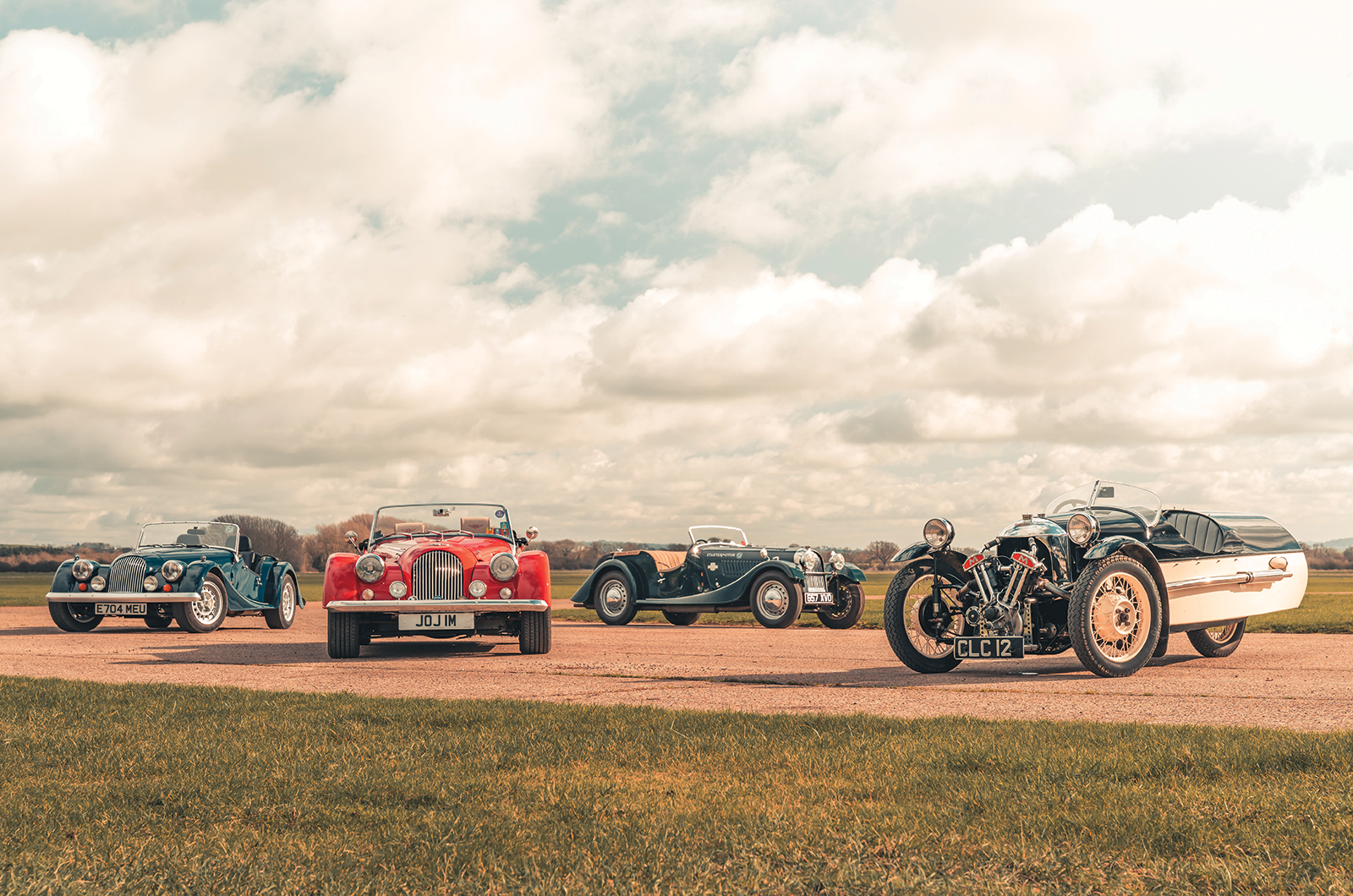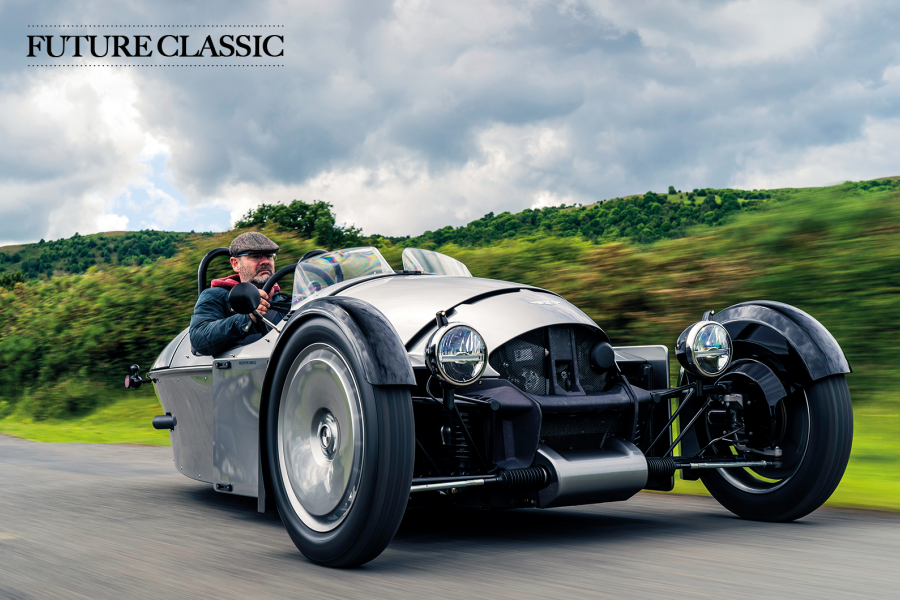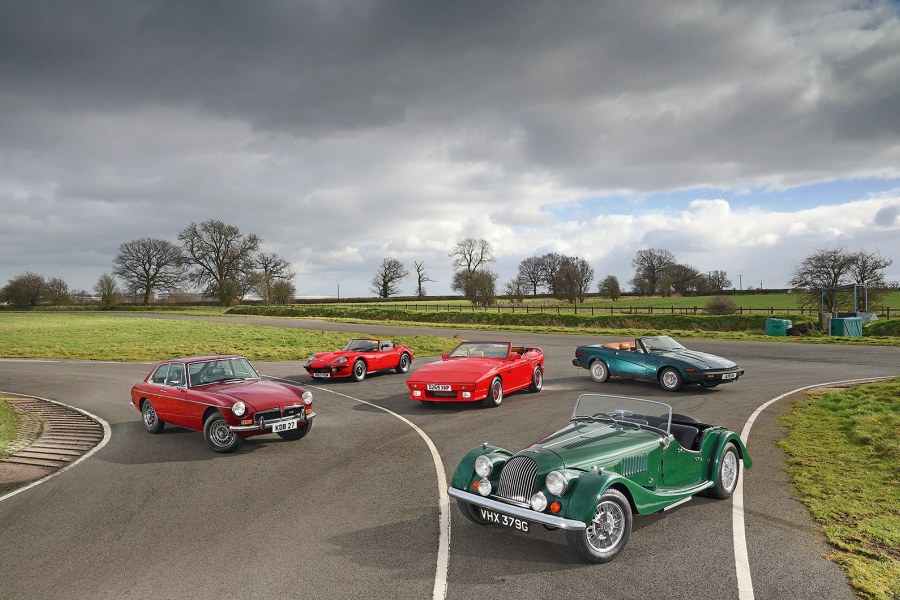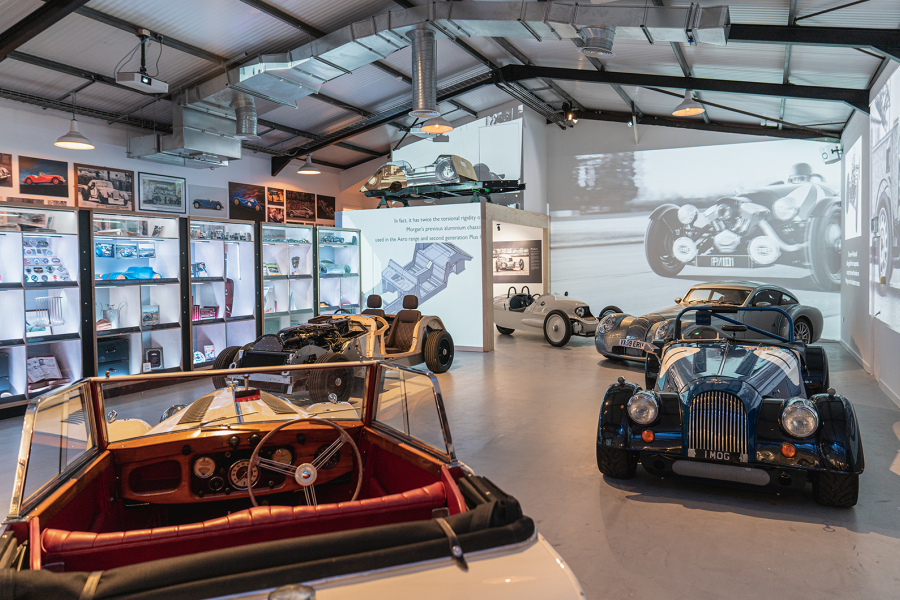Even a decade later, with the launch of the radical (by Morgan standards) Plus 4 Plus, there was a strong hint that he might adopt a more modern approach.
But that project bombed in commercial terms and ever since (save the now discontinued Aero 8 of 2000-2018) the company’s product strategy has unashamedly embraced the past.
Traction can be an issue in the Morgan Roadster, but there is a rich exhaust note to enjoy
Which is perfectly illustrated by our second pairing from Malvern.
Running in cylinder-, rather than age-order, the Roadster arrived in 2004, replacing the Plus 8, as supply of that model’s venerable engine ran dry.
Unlike the Plus 8, the Roadster was also offered as a more family-friendly four-seater, complementing the two-seater we have at Bicester today.
Initially powered by Ford’s then relatively new and advanced 3-litre Duratec V6, as seen in the Mondeo, the Roadster was Morgan’s first six-cylinder model, producing between 204 and 223bhp, depending on build year.
The Morgan Roadster’s simplified, polished-walnut dashboard
‘Our’ car, however, is a later model, fitted with the 3.7-litre, 280bhp Duratec Cyclone V6.
Jim Rowe has owned the car from new and uses it extensively, having enjoyed multiple road trips to Italy.
The dash layout is not dissimilar to that of the decades-older Plus 4, although the switchgear is tidier and more intuitive to use, and the driving position considerably more comfortable thanks to adjustable seats and a steering wheel not borrowed from the Titanic.
The Morgan Roadster’s recognisable badge and ‘waterfall’ grille
The thing is, we are now in a Morgan that produces four times the power of its forebear, yet still employs the same basic chassis design as the Plus 4 we’ve just stepped out of – albeit with a raft of detail revisions.
No question, the Roadster feels blisteringly quick: it’ll blast to its 7000rpm redline effortlessly, accompanied by a strident, cultured V6 bark.
Its mid-range performance is exceptional, too, allowing you to dip into a deep well of torque in higher gears.
But it all feels a bit too much for a car whose underpinnings hark largely from the pre-war era.
The Morgan Roadster’s 3.7-litre Ford V6 musters 280bhp
Even accelerating hard in a straight line on a dry track, the car feels overwhelmed, twitching at every gearchange.
The steering has a little too much power assistance, too, feeling pointy and nervous just off the straight-ahead, though it loads up progressively enough as you apply more lock through corners.
But when you do, the front end feels untidy and detached, sending unwanted kickback through the steering system.
Braking performance, though strong enough, is also hampered by slightly mushy, inconsistent pedal feel.
The Morgan Roadster has comfortable, adjustable seats
Am I being too harsh? I don’t believe so.
In isolation, there’s little wrong with either the Roadster’s chassis or its powertrain; it’s just that the two don’t seem to be compatible.
On the face of it, that does not bode well for the Plus 8, which is of similar engine capacity.
Another of Tony’s charges, this car rolled out of the Pickersleigh Road works in 1988.
The Morgan Roadster goes well, but steers less convincingly
Once again based on the Plus 4’s architecture, the model was unveiled in 1968, Morgan being the first external manufacturer to adopt Rover’s light, Buick-derived 3.5-litre V8, after it was launched in the P5B saloon.
Race engineer Maurice Owen was tasked by the sports-car maker with shoehorning the all-aluminium unit into the existing chassis, and with it came a new collapsible steering column and cooling system, including an electric fan.
There was also a switch from dynamo to alternator, along with myriad detail changes to the electrical system and equipment list.
The Plus 8 takes the Morgan chassis to the limit, but it rarely feels overwhelmed
Originally producing 155bhp, as in the P5B, the Plus 8’s powertrain was developed over the years in line with Rover’s products, with up to 4.6 litres available.
With 20 years of model development behind it, the 3.5-litre engine in Tony’s car not only benefits from electronic fuel injection (replacing the twin SU carbs), upping output to 190bhp, but also the excellent five-speed ’box from the Rover SD1, replacing the earlier Moss four-speed.
It has a 2in-wider chassis than the 1968 model, and a 4in-wider aluminium body (an option over the standard steel), along with an unassisted steering rack and limited-slip differential.
Tony’s car also has SSL front springs with low-friction bushes (a common upgrade).
Rover switchgear in the Morgan Plus 8
This was the Morgan sports car that, for many years, could out-accelerate any other UK production car between 20 and 80mph, such was its torque-to-weight ratio – a potent 217lb ft per tonne – which soon becomes apparent.
Befitting its position at the top of the range, the Plus 8’s hide-trimmed cabin is well appointed, the dark veneered dash inset with a bank of four central auxiliary dials, in addition to the main clocks before you for revs and speed.
The Rover powertrain brings similarly sourced controls (the column stalks most obviously), but everything is laid out logically and you can imagine that spending a day behind the small, leather-rimmed three-spoke wheel would be no great sacrifice.
The Morgan Plus 8’s fuel-injected V8 is full of character
The engine is everything you expect it to be: docile and flexible, but, even at idle, infused with a latent potency that is unleashed the second you prod the long-travel throttle.
You don’t need to work the engine much above 4500rpm to get the full effect and, while it’s not as quick outright as the Roadster, the intoxicating woofle from its V8 alone makes driving the Plus 8 an utter joy.
The shift from the SD1 ’box is quite deliberate, the top of the gearlever cranked over to avoid grazing your knuckles on the lower dash, but you can use it sparingly: it will happily pull cleanly from 500rpm in top.
The Morgan Plus 8 offers excellent grip and feedback
Dynamically, it feels as if we’re exploring the outer envelope of the old chassis’ limits – but not quite exceeding them, as in the Roadster.
Even with uprated springs, the front end shimmies when you attack corners, though overall grip is good.
The steering has plenty of heft, giving you feedback and kickback in equal measure – all par for the Morgan course.
The unservoed brakes (discs front, drums rear) require a decent shove from high speeds, but repay with lots of feel.
In short, the Plus 8’s speed, substance and subtlety make it the most engaging and usable car here by some margin.
The Morgan Plus 8 with its V-twin-engined ancestor in the background
This is a story of two halves: the Super Sports three-wheeler and early Plus 4 were low-cost, enthusiast machines which held their own in the immediate pre- and post-war markets versus contemporary rivals.
The Roadster and Plus 8 cannot be so judged: their handcrafted charm and freeze-frame designs, blended with more modern, powerful engines, largely transcend objective analysis – though in the case of the Roadster, only up to a point.
Which is why, on this evidence, the Plus 8 is the one that gets the balance just right.
Images: Max Edleston
Thanks to: Bicester Heritage; StarterMotor; OxMOG
Factfile
Morgan Super Sports
- Sold/number built 1933-’39/820
- Construction tubular steel chassis, steel body over ash frame
- Engine alloy-crankcase, iron-heads, ohv 990cc 50° V-twin, single Amal carburettor
- Max power 42bhp @ 4800rpm
- Max torque n/a
- Transmission three-speed manual, RWD
- Suspension: front independent, by sliding pillars, helical springs, telescopic dampers rear two quarter-elliptic springs, lever-arm damper
- Steering epicyclic reduction
- Brakes drums
- Length 10ft 4in (3150mm)
- Width 4ft 11in (1499mm)
- Height n/a
- Wheelbase 7ft 3in (2209mm)
- Weight 958lb (434kg)
- Mpg 40
- 0-60mph n/a
- Top speed 73mph
- Price new £136 10s (1939)
- Price now £50,000*
Morgan Plus 4
- Sold/number built 1950-’69/6853
- Construction Z-section steel chassis, aluminium/steel panels over ash frame
- Engine all-iron, ohv 2088cc ‘four’, single Solex carburettor
- Max power 68bhp @ 4300rpm
- Max torque 112lb ft @ 2300rpm
- Transmission four-speed manual, RWD
- Suspension: front independent, by sliding pillars, coil springs, telescopic dampers rear live axle, semi-elliptic springs, lever-arm dampers
- Steering cam gear
- Brakes drums
- Length 12ft 1in (3683mm)
- Width 4ft 8in (1422mm)
- Height 4ft 4in (1321mm)
- Wheelbase 8ft (2438mm)
- Weight 1848lb (838kg)
- Mpg n/a
- 0-60mph 12.8 secs
- Top speed 85mph
- Price new £610 (1959)
- Price now £25-45,000*
Morgan Roadster
- Sold/number built 2004-’19/2117
- Construction Z-section steel chassis, aluminium/steel panels over ash frame
- Engine all-alloy, dohc-per-bank 3726cc 60° V6, fuel injection
- Max power 280bhp @ 6000rpm
- Max torque 280lb ft @ 4500rpm
- Transmission five-speed manual, RWD
- Suspension: front independent, by sliding pillars, coil springs rear live axle, semi-elliptic springs; telescopics f/r
- Steering power-assisted rack and pinion
- Brakes discs front, drums rear
- Length 13ft 2in (4010mm)
- Width 5ft 7in (1720mm)
- Height 4ft 1in (1220mm)
- Wheelbase 8ft 2in (2490mm)
- Weight 2204lb (1000kg)
- Mpg 28
- 0-60mph 5.5 secs
- Top speed 140mph
- Price new £38,250 (2012)
- Price now £30-50,000*
Morgan Plus 8
- Sold/number built 1968-2004/6130
- Construction Z-section steel chassis, aluminium/steel panels over ash frame
- Engine all-alloy, ohv 3528cc 90° V8, Lucas L-Jetronic fuel injection
- Max power 190bhp @ 5280rpm
- Max torque 220lb ft @ 4000rpm
- Transmission five-speed manual, RWD
- Suspension: front independent, by sliding pillars, coil springs, telescopic dampers rear live axle, semi-elliptic springs, lever-arm dampers
- Steering rack and pinion
- Brakes discs front, drums rear
- Length 13ft (3962mm)
- Width 5ft 3in (1600mm)
- Height 4ft 4in (1320mm)
- Wheelbase 8ft 2in (2489mm)
- Weight 2022lb (915kg)
- Mpg 20.9
- 0-60mph 5.6 secs
- Top speed 120mph
- Price new £15,435.88 (1987)
- Price now £25-50,000*
*Prices correct at date of original publication
Enjoy more of the world’s best classic car content every month when you subscribe to C&SC – get our latest deals here
READ MORE
Old dogs, new quicks: Morgan Aero 8 and Jensen S-V8
Future classic: Morgan Plus Six
Austin Ten adventure: kick-starting the passion
Simon Hucknall
Simon Hucknall is a senior contributor to Classic & Sports Car
